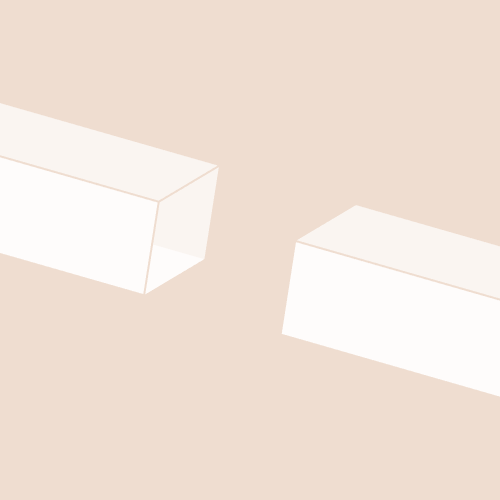dechoes-AnimatedLoop

I had a really fun time with this assignment. It encompassed multiple challenges into one: the understanding of physics, coding decently, the idea generation itself and intelligent aesthetic decisions. I am quite happy with how my seamless gif turned out, however I wish the idea could have been more clever, providing the viewer with a real “oh shit” moment. I chose the Double Exponential Sigmoid function, because it mimicked the magnetic fields nicely, slow at first and quick towards the middle piece.
Preliminary Sketch:

Here is the code:
//Many thanks to Golan Levin for his help and Pattern Master, which now resides in my "Important Files" File //And thanks to Claire, for teaching an a full grown adult how to airdrop String myNickname = "dechoes"; int nFrames = 360; int nElapsedFrames; boolean bRecording; void setup() { size(500, 500, P3D); smooth(8); ortho(); bRecording = false; nElapsedFrames = 0; } void keyPressed() { if ((key == 'f') || (key == 'F')) { bRecording = true; nElapsedFrames = 0; } } void draw() { background(239, 221, 208); float t01 = (frameCount%nFrames) / (float) nFrames; pushMatrix(); //Global PushMatrix { translate(width/2, height/2, 0); //Setting the origin at the center rotateZ( radians(16)); rotateY( radians(-20)); rotateX( radians(70)); //drawAxes(); stroke(239, 221, 208); stroke(239, 221, 208); strokeWeight(2); fill(252, 98, 55, 180); noFill(); fill(255, 255, 255, 200); // Middle Box pushMatrix(); float r = map(sin(t01 * 40.0), -1, 1, 0, 1); // WHY ARE YOU ACCELERATING float boxX = 3 * map(r, 0, 1, -1, 1); float boxY = 4 * map(r, 0, 1, -1, 1); float boxZ = 0; if (true) { float shiftedT01 = (t01 + 0.0005)%1.0; boxZ = 1.3 * map (sin(shiftedT01 * TWO_PI), -1, 1, 0, 1); boxZ = 400 * pow(boxZ, 9.0); } translate(boxX, boxY, boxZ); box(100, 150, 100); popMatrix(); fill(137, 157, 37, 200); noFill(); fill(255, 255, 255, 180); // Top Box float s = map(sin(t01 * TWO_PI), -1, 1, 0, 1); s = function_DoubleExponentialSigmoid (s, 0.8); float bx = 130 * map(s, 0, 1, -1, 1); float by = 0; //Vibrations float bz = 10 * pow((1-t01), 8) * sin((t01 + 2) * TWO_PI * 80); pushMatrix(); translate(- 430 + bx, by, bz); box(450, 150, 100); popMatrix(); // Bottom Box float t = map(sin(t01 * TWO_PI), -1, 1, 0, 1); t = function_DoubleExponentialSigmoid (t, 0.8); float cx = 130 * map(t, 0, 1, -1, 1); float cy = 0; float cz = 10 * pow((1-t01), 8) * sin((t01 + 2) * TWO_PI * 80); pushMatrix(); translate(430 - cx, cy, cz); box(450, 150, 100); popMatrix(); } popMatrix(); // Global PopMatrix //--------------------------------------------------------------- // If we're recording the output, save the frame to a file. if (bRecording) { saveFrame("frames/" + myNickname + "_frame_" + nf(nElapsedFrames, 4) + ".png"); nElapsedFrames++; if (nElapsedFrames >= nFrames) { bRecording = false; } } } //------------------------------------------------------------------ float function_DoubleExponentialSigmoid (float x, float a) { //functionName = "Double-Exponential Sigmoid"; float min_param_a = 0.0 + EPSILON; float max_param_a = 1.0 - EPSILON; a = constrain(a, min_param_a, max_param_a); a = 1-a; float y = 0; if (x<=0.5) { y = (pow(2.0*x, 1.0/a))/2.0; } else { y = 1.0 - (pow(2.0*(1.0-x), 1.0/a))/2.0; } return y; } //------------------------------------------------------------------ void drawAxes() { strokeWeight(2); stroke(255, 0, 0); //RED X line(0, 0, 0, 300, 0, 0); stroke(0, 128, 0); //GREEN Y line(0, 0, 0, 0, 300, 0); stroke(0, 0, 255); //BLUE Z line(0, 0, 0, 0, 0, 300); noStroke(); } |
Here is a prior color scheme I tried:
